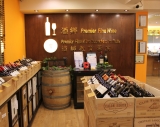The Yarra Valley is Victoria's oldest wine region, has over 3,600 hectares under vine and crushes around 19,000 tonnes of grapes annually. It is also one of Victoria's most visited wine areas, located less than an hour's drive east of Melbourne's CBD or south-east of the airport.
The Yarra Valley was Victoria's first wine growing district and has a history stretching back 170 years. Vines were first planted in 1838 and viticulture spread rapidly through the 1860s and 1870s. However, increased demand for fortified wine saw Yarra Valley wine production cease in 1921. Replanting began in the late 1960s and by the early 1990s the area under vine passed the high point of the 19th century. The Yarra Valley is now recognised as one of Australia's foremost cool climate regions, capable of making classic styles from a wide range of varieties. It is impossible to favour a single variety as the star performer because the Yarra Valley offers sparkling wine (including those made in partnership with French Champagne houses), fine Chardonnay, complex Pinot Noir, silky Shiraz and world-class Cabernet Sauvignon.
The Yarra Valley is one of Australia's coolest regions, with elevation varying from 50m-400m. Rainfall is winter/spring dominant, with the summer relatively cool, dry and humid. There is limited maritime influence. The small diurnal temperature range reflects the proximity of the sea.
Harvest typically commences in early March with Pinot Noir and finishes with Cabernet Sauvignon in early May. Frost is rarely a problem, but can affect the lower vineyards on the valley floor from time to time.
With a seven-month growing season, rainfall of 750-950mm (often less rather than more) and restricted water holding capacity in some soils, irrigation is considered essential − although the extent of its use does vary significantly between producers.
There are two basic soil types. The traditional areas on the northern side of the valley are grey to grey-brown in colour on the surface and range from loamy sand to clay loam in consistency with red-brown clay subsoils, frequently impregnated with rock. Most are relatively acidic and low in fertility, but are generally well drained. The other major soil type is the immensely deep and fertile red volcanic soil to be found at Seville, Hoddles Creek and elsewhere on the southern (Warburton) side of the valley. Great care in cultivation should be taken with the latter soil type to devigorate vines planted in it, so that they produce fruit and not luxuriant foliage.
Info: Australian Wine & Brandy Corporation www.wineaustralia.com












